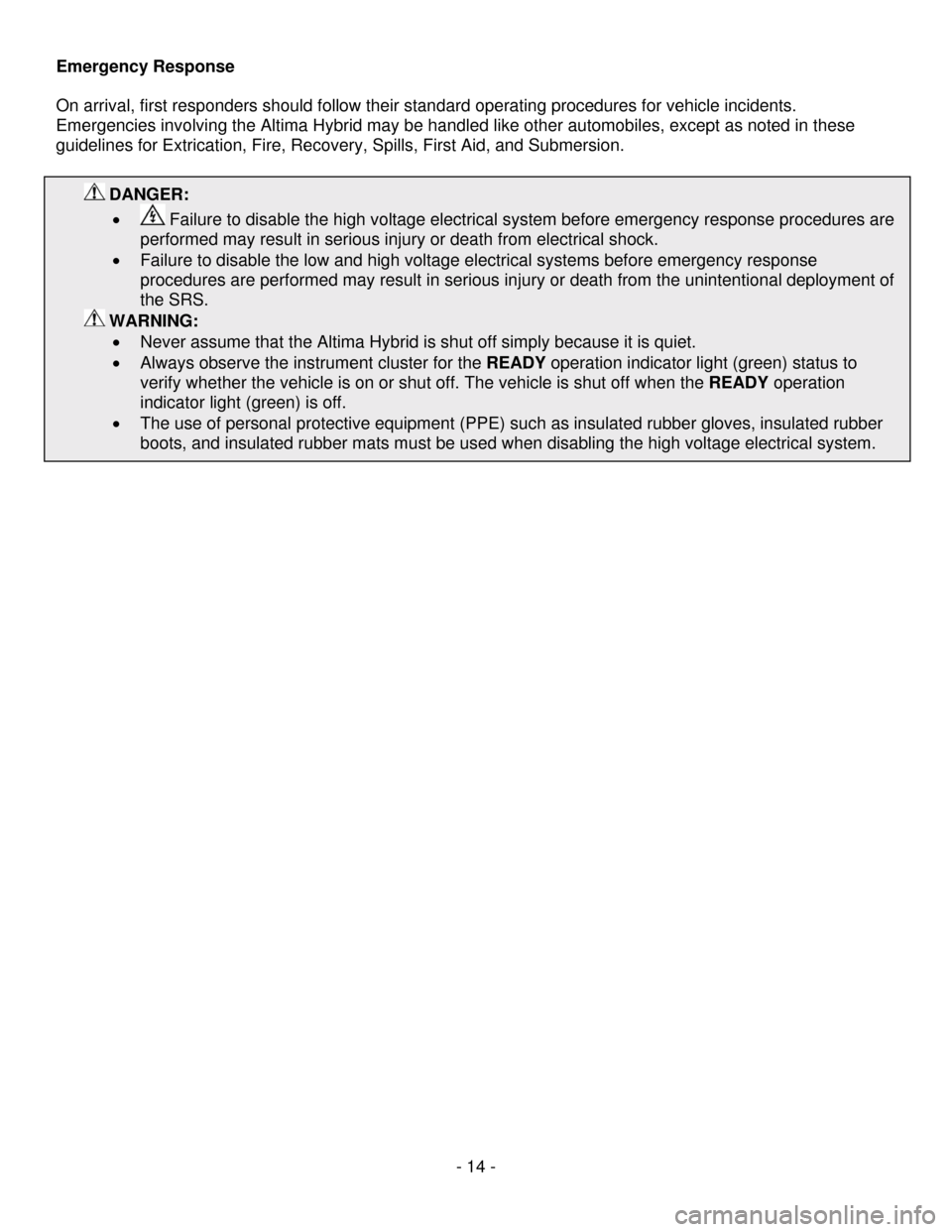Page 3 of 27

- 3 -
Foreword
Nissan released the Nissan Altima Hybrid in North America in January of 2007. The Nissan Altima Hybrid runs
on conventional gasoline and a traction motor. The basic vehicle systems and features of the Altima Hybrid are
the same as those of the conventional Altima, except where noted in this guide. This First Responder’s Guide
was published to help educate and assist first responders in the safe handling of the Altima Hybrid and its
technology.
A high voltage battery is used to power the traction motor, generator, electric air conditioning compressor,
voltage converter, and inverter unit. A separate 12 volt battery is used to power other electrical devices such as
the radio, horn, headlamps, and instrument cluster gauges. A number of safeguards have been designed to
ensure that the high voltage Nickel Metal Hydride (Ni-MH) battery is kept safe and secure in the event of an
accident.
The Altima Hybrid utilizes both low and high voltage systems:
Low voltage system
• A 12 volt DC negative chassis ground body electrical system
High voltage system
• A 245 volt DC high voltage battery
• A harness that carries high voltage between the high voltage battery, converter, inverter unit, transaxle
and electric air conditioning compressor
• A converter which converts 245 volts DC to 42 volts DC for the electric power steering (EPS) system
• A converter which converts 245 volts DC for charging the 12 volt battery
• An inverter unit which delivers up to 650 volts AC to the transaxle
• A transaxle which houses a traction motor and generator
• A 245 volt DC, electric motor driven electric air conditioning compressor
High voltage electrical safety is an important factor in the emergency handling of the Altima Hybrid. It is
important to recognize and understand the disabling procedures and warnings throughout this guide.
Additional topics in this guide include:
• Nissan Altima Hybrid identification
• Hybrid system component locations and descriptions
• Extrication, fire, recovery, and additional emergency response information
• Roadside assistance information
This First Responders Guide is intended to assist first responders in the safe handling of a Nissan Altima
Hybrid. The information contained in this guide is somewhat simplified and intended to be used as a
technical reference. Please refer to the Nissan Service Manual for information related to vehicle repair.
Page 12 of 27
- 12 -
• A ground fault monitor continuously monitors for high voltage leakage to the metal chassis while the
vehicle is running. If a malfunction is detected, the high voltage ECU will illuminate the hybrid system
warning light in the instrument cluster.
• The high voltage battery relays (SMR1 and SMR2) will automatically open to stop the electrical flow in a
frontal collision that is sufficient enough to activate the supplemental restraint system (SRS).
Page 14 of 27

- 14 -
Emergency Response
On arrival, first responders should follow their standard operating procedures for vehicle incidents.
Emergencies involving the Altima Hybrid may be handled like other automobiles, except as noted in these
guidelines for Extrication, Fire, Recovery, Spills, First Aid, and Submersion.
DANGER:
•
Failure to disable the high voltage electrical system before emergency response procedures are
performed may result in serious injury or death from electrical shock.
• Failure to disable the low and high voltage electrical systems before emergency response
procedures are performed may result in serious injury or death from the unintentional deployment of
the SRS.
WARNING:
• Never assume that the Altima Hybrid is shut off simply because it is quiet.
• Always observe the instrument cluster for the READY operation indicator light (green) status to
verify whether the vehicle is on or shut off. The vehicle is shut off when the READY operation
indicator light (green) is off.
• The use of personal protective equipment (PPE) su ch as insulated rubber gloves, insulated rubber
boots, and insulated rubber mats must be used when disabling the high voltage electrical system.
Page 27 of 27
- 27 -
8. Hold down the brake pedal and press the START button. The
vehicle instrument cluster will light up, and the READY operation
indicator light (green) will come ON.
9. After the READY operation indicator light (green) in the instrument
cluster comes ON, carefully disconnect the negative cable and
then the positive (+) cable.
10. Replace the vent caps (if so equipped). Be sure to dispose of the cloth used to cover the vent holes, as
it may be contaminated with corrosive acid.
The high voltage battery CANNOT be jump started.
CAUTION:
• If the READY operation indicator light (green) does not come on, press the START button to
turn the Hybrid System OFF. Carefully disconnect the negative (-) cable, then the positive (+)
cable. Have the vehicle taken to a Nissan dealership for repair.